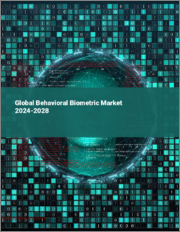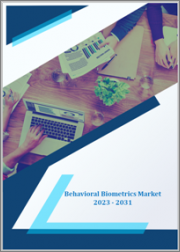
|
시장보고서
상품코드
1445882
행동 바이오메트릭스 : 세계 시장 전망(2022-2027년)Global Market Forecast: Behavioral Biometrics, 2022-2027 |
||||||
세계 행동 바이오메트릭스 시장은 2027년까지 11.9%의 연평균 복합 성장률(CAGR)을 나타낼 것으로 예상됩니다.
전 세계 기업들이 디지털 전환(Digital Transformation, 이하 DX)을 추진하는 배경에는 비용 절감, 효율성 및 가용성 향상, 고객 경험 개선이라는 목적이 있습니다. 인터넷에서 제공되는 서비스(뱅킹, 쇼핑, 거래, 소셜 네트워킹 등)가 증가함에 따라 부정행위가 증가하고 있습니다. 이에 따라 사이버 범죄자들은 랜섬웨어, 신원 도용, 피싱, 계정 탈취, 봇넷 공격 등 점점 더 정교한 방법으로 사이버 공격을 하고 있습니다. 갈수록 교묘해지는 사이버 공격에 대응하기 위해 각 조직은 데이터 유출을 방지하고 시스템 보안을 강화하기 위해 비밀번호 기반 인증, 다단계 인증, 토큰 기반, 인증서 기반, 생체인증 등 다양한 사용자 인증 방식을 채택하고 있습니다. 행동 생체인식 솔루션은 키 스트로크, 기기 조작, 터치스크린 조작, 마우스 움직임, 탐색 패턴, 양식의 컨텍스트 및 유창성, 고객 라이프사이클 전반에 걸친 데이터 숙련도와 같은 행동, 인지, 반응 등의 속성을 기반으로 사용자를 수동적이고 지속적으로 모니터링하고 분석합니다.의 속성을 기반으로 사용자를 모니터링, 분석, 인증합니다.
본 보고서에서는 세계의 행동 바이오메트릭스 시장에 대해 분석했으며, 솔루션 개요와 시장의 기본 구조, 전체 시장 규모 동향 전망, 도입 방식별/지역별/업종별/고객 유형별 상세 동향, 업계 관계자가 향후 취해야 할 행동 등을 조사했습니다.
목차
제1장 분석 개요
- 시장 전망(2023년) : 주요 분석 결과와 결론
- 주요 예측
제2장 행동 바이오메트릭스 시장 개요
- 시장 정의와 범위
- 매출 유형
- 분석 대상 지역
- 분석 대상 업종
제3장 행동 바이오메트릭스 시장 예측 분석
- 시장 가속 요인과 억제요인
- 시장 예측 : 시장 전체
- 시장 예측 : 도입 방법별
- 클라우드
- 온프레미스
- 시장 예측 : 지역별
- 캐나다
- 중유럽 및 동유럽
- 일본
- 라틴아메리카
- 중동 및 아프리카
- 미국
- 서유럽
- 일본/중국을 제외한 아시아(AxJC)
- 중국
- 시장 예측 : 업계별
- 은행 및 금융 서비스
- 일렉트로닉스 및 통신
- 소매업 및 E-Commerce
- 전문 서비스
- 의료 및 생명과학
- 제조업
- 미디어 및 엔터테인먼트
- 정부 및 공공 부문
- 교육
- 에너지 및 유틸리티 기타
- 기타
- 시장 예측 : 고객 유형별
- 중소기업
- 대기업
제4장 애널리스트의 제안
제5장 부록
LSH 24.03.21Quadrant Knowledge Solutions Reveals that Behavioral Biometrics Market is Projected to Register a CAGR of 11.9% by 2027.
The digital transformation journey continued by organizations globally is driven by the objective of reducing cost, increasing efficiency and availability, and improving customer experience. The increase in services provided over the Internet such as banking, shopping, transactions, socializing, and more is giving rise to fraudulent activities. To take advantage of this, cybercriminals are using increasingly sophisticated techniques to carry out cyberattacks through ransomware, identity theft, phishing, account takeover, botnet attacks and more. To combat the issue of rising sophisticated cyberattacks, organizations are increasingly adopting various user authentication methods such as password-based authentication, multi-factor authentication, token-based, certificate-based and biometrics authentication to prevent data breaches and improve the security of the systems. A behavioural biometrics solution passively and continuously monitors, analyses, and authenticates users based on their behavioural, cognitive, and response attributes such as keystroke dynamics, device handling, touchscreen interaction, mouse movements, navigation pattern, form context and fluency, and data familiarity across the entire customer lifecycle.
Table of Contents
Chapter 01: Research Summary
- 2023 Market Outlook: Top Research Findings and Key Takeaways
- Top predictions
Chapter 02: Behavioral Biometrics Market Overview
- Market Definition and Scope
- Revenue Type
- Geographical Regions
- Industry Verticals
Chapter 03: Behavioral Biometrics Market Forecast Analysis
- Market Accelerators and Market Restraints
- Market Forecast by Total Market
- Market Forecast by Deployment Type
- Cloud
- On-Premises
- Market Forecast by Geographical Regions
- Canada
- Central & Eastern Europe
- Japan
- Latin America
- Middle East & Africa
- USA
- Western Europe
- Asia Ex-Japan China (AxJC)
- China
- Market Forecast by Industry Verticals
- Banking and Financial Services
- Electronics & Telecom
- Retail and eCommerce
- Professional Services
- Healthcare and Life Sciences
- Manufacturing
- Media & Entertainment
- Government and Public Sectors
- Education
- Energy & Utility Others
- Others
- Market Forecast by Customer Types
- SMB
- Large
- Enterprise
Chapter 04: Analyst Recommendations
- Analyst Recommendations
Chapter 05: Appendix
- Research Methodologies



















